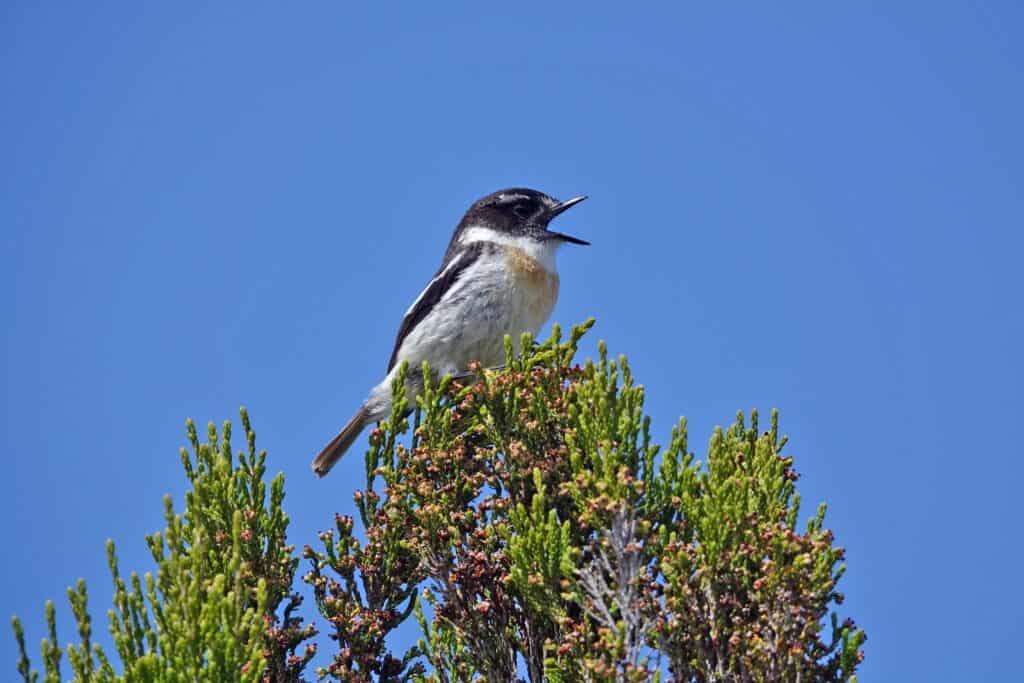Stonechat
Saxicola torquatus, Saxicola caprata, and others
Their songs are harsh and sound like two rocks hitting together.
Advertisement
Stonechat Scientific Classification
- Kingdom
- Animalia
- Phylum
- Chordata
- Class
- Aves
- Order
- Passeriformes
- Family
- Muscicapidae
- Genus
- Saxicola
- Scientific Name
- Saxicola torquatus, Saxicola caprata, and others
Read our Complete Guide to Classification of Animals.
Stonechat Conservation Status
Stonechat Facts
- Prey
- They eat insects, including worms, slugs, and snails
- Main Prey
- Grasshoppers and dragonflies
- Name Of Young
- Chicks
- Group Behavior
- Social
- Fun Fact
- Their songs are harsh and sound like two rocks hitting together.
- Estimated Population Size
- Unknown but stable
- Biggest Threat
- Habitat loss
- Most Distinctive Feature
- Orange breast and flanks
- Distinctive Feature
- large heads and thick necks
- Wingspan
- 11 inches
- Incubation Period
- 13 to 14 days
- Age Of Independence
- Around one month
- Age Of Fledgling
- 12 to 16 days
- Habitat
- Shrublands and grasslands
- Predators
- Birds of prey, foxes, snakes
- Diet
- Insectivore
- Lifestyle
- Diurnal
- Favorite Food
- Grasshoppers
- Type
- Bird
- Common Name
- Stonechat
- Number Of Species
- 14
- Location
- Asia, Europe, Africa
- Nesting Location
- Dense vegetation close to the ground
- Migratory
- 1
View all of the Stonechat images!
“Their sharp calls sound like two stones being knocked together.”
Summary
The stone chat is a small passerine bird with an enormous range spanning three continents. Most species are nonmigratory or short-distance migrants, but many prefer to live in their habitats year-round. They predominately inhabit grassland and scrublands, placing their nests in low vegetation. Find out everything there is to know about the stone chat genus, including where they live, where they migrate, and how they reproduce.
5 Amazing Stone Chat Facts
- Stonechats have an extensive range, covering over 100 countries across three continents.
- Their songs are harsh and sound like two rocks hitting together.
- Grasshoppers and dragonflies are their favorite food
- The Fuerteventura stonechat is “near threatened” due to habitat loss
- Stonechats are monogamous during the breeding season but don’t typically mate for life
Where to Find the Stone Chat
The stone chat lives in over 100 countries across three continents, including Russia, France, Ethiopia, China, Greece, and many more. You can find it throughout Europe, Asia, and Northern, Central, and Southern coastal areas of Africa (from Morrocco to Angola to South Africa). Stonechats in Europe inhabit shrubland, coastal dunes, and rough grasslands. You can find them in open grasslands, shrublands, swamp edges, and cultivated land in Africa. Some populations inhabit mountainous areas in Southwest Arabia and Madagascar.
Stone Chat Nest
Females build their nests in dense vegetation close to the ground. She constructs a loose cup of dried grass and lines it with animal hair and feathers. Occasionally, stonechats will place their nest in rock crevices or holes in the ground.
Scientific Name
The stonechat (Saxicola) is in the Muscicapidae family, which are small passerine birds restricted to the Old World. They are small arboreal insectivores, encompassing over 300 species. The genus, Saxicola, is Latin for “rock-dwelling” and contains 15 species of “chats.”
The 15 species accepted in the Saxicola genus:
- Whinchat
- White-browed bush chat
- White-throated bush chat
- Canary Islands stonechat
- European stonechat
- Siberian stonechat
- Amur stonechat
- African stonechat
- Madagascar stonechat
- Reunion stonechat
- White-tailed stonechat
- Pied bush chat
- Jerdon’s bush chat
- Grey bush chat
- White-bellied bush chat
Size, Appearance, & Behavior

Their songs are harsh and sound like two rocks hitting together.
©OUESTUSA/Shutterstock.com
Stonechats are small passerine birds, measuring between four and five inches long and weighing 0.3 to 0.9 ounces, with a seven to eleven-inch wingspan. They have stout bodies, large heads, and thick necks. Males have dark brown heads, wings, and throats, with white patches on the sides of its neck. Their breasts and flanks are orange, transitioning to a grayish-white on their undersides. Females are a mottled brown color. They also feature short, pointed bills, rounded wings, and short tails. Their songs are harsh and sound like two rocks hitting together, and their calls are quick and squeaky.
Migration Pattern and Timing
Most stonechats are either nonmigratory, meaning they are residents in their environments. Some species are partial migrants who may move slightly south for winter. For instance, the common stonechat stays year-round in particular habitats. It’s a resident in Central and Southern Africa (Angola, South Africa, etc.), Madagascar, and parts of Europe (Spain, France, and Italy). In places like China, Russia, Hungary, and Ukraine, stone chats will stay for the breeding season and then move south for winter in areas like Germany, Austria, Morocco, and Algeria.
Diet
Stonechats are insectivores that supplement with seeds and berries.
What Does the Stone Chat Eat?
The stone chat eats a wide variety of insects, including worms, slugs, and snails. It primarily eats grasshoppers and dragonflies. But they will also eat invertebrates like spiders. It will eat berries, seeds, and nuts from bushes and trees during winter. And occasionally, they will eat small frogs and lizards. It forages for food on the ground and in low vegetation like shrubs and hedges.
Predators, Threats, and Conservation Status
The IUCN lists most stonechat species as LC or “least concern.” Due to their extensive range and large, stable population, they do not qualify for “threatened” status. The Fuerteventura Stonechat (Saxicola dacotiae) is the only exception and has an NT or “near threatened” status. This species has a small range in the Canary Islands and is experiencing habitat loss from urbanization and the agricultural industry. Studies also indicate tropical stonechats are less likely to lay a second brood due to nest predation and a limited food supply.
What Eats the Stone Chat?
Not much is known about the stonechat’s predators. But they (and their chicks) may fall victim to foxes, birds of prey, crows, ravens, and snakes. Males and females defend their nests by producing alarm and defense calls.
Reproduction, Young, and Molting
Stonechats breed around one-year-old. And while they are monogamous during the breeding season, they don’t typically mate for life. Females lay four to six pale blue-green eggs early in the morning during daily intervals. She incubates them by herself for 13 to 14 days, but both parents care for and feed the chicks. Nestlings fledge the nest 12 to 16 days after hatching, but both parents tend to them for four to five days. Males take over feedings for another 10 to 15 days, while the female begins making another nest for her second brood. Stonechats raise two to three broods in one season. These birds have a lifespan between four and eight years.
Population
The exact global population of the stonechat is unknown, but most species appear stable. The Fuerteventura Stonechat is the only stonechat with decreasing numbers. However, not enough research has been done to give an accurate estimate of the magnitude of loss. Researchers believe they are declining due to ongoing habitat loss and degradation.
Up Next:
View all 293 animals that start with SStonechat FAQs (Frequently Asked Questions)
Why is it called a stonechat?
Their calls sound like two stones knocking together.
Are stonechats common in the UK?
They are common in the UK during the warmer months. They predominantly reside in western and southern areas of the UK.
Are stonechats migrant?
Most are either nonmigratory or or partial migrants, who move short distances during winter.
Are stonechats endangered?
The IUCN lists most stonechat species as LC or “least concern.” Due to their extensive range and large, stable population, they do not qualify for “threatened” status.
Where does a stonechat nest?
Females build their nests in dense vegetation close to the ground in shrublands, grasslands, and coastal dunes.
What do stonechats look like?
They have stout bodies with large heads and thick necks. Adult males have dark brown heads, wings, and throats, with white patches on the sides of its neck. Their breasts and flanks are orange, transitioning to a grayish-white on their undersides.
How big are stonechats?
Stonechats measure between four and five inches long and weigh 0.3 to 0.9 ounces, with a seven to eleven-inch wingspan.
Thank you for reading! Have some feedback for us? Contact the AZ Animals editorial team.
Sources
- Red List, Available here: https://www.iucnredlist.org/search?query=skua&searchType=species
- JSTOR / Proceedings: Biological Sciences / Alexander Scheuerlein, Thomas J. Van't Hof and Eberhard Gwinner, Available here: https://www.jstor.org/stable/3068014
- Elsevier / Animal Behaviour / P.W.Greig-Smith, Available here: https://www.sciencedirect.com/science/article/abs/pii/S0003347280800698

















